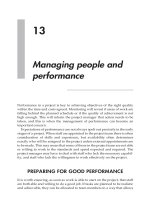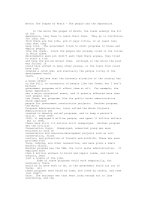Managing people and performance
Bạn đang xem bản rút gọn của tài liệu. Xem và tải ngay bản đầy đủ của tài liệu tại đây (108.2 KB, 12 trang )
13
Managing people and
performance
Performance in a project is key to achieving objectives of the right quality
within the time and costs agreed. Monitoring will reveal if areas of work are
falling behind the planned schedule or if the quality of achievement is not
high enough. This will inform the project manager that action needs to be
taken, and this is when the management of performance can become an
important concern.
Expectations of performance are not always spelt out precisely in the early
stages of a project. When staff are appointed to the project team there is often
consideration of skills and experience, but availability often determines
exactly who will be assigned to the project unless external appointments are
to be made. This may mean that some of those in the project team are not able
or willing to work to the standards and speed expected and required. The
project manager may have to deal with staff who lack the necessary capabil-
ity, and staff who lack the willingness to work effectively on the project.
PREPARING FOR GOOD PERFORMANCE
It is worth ensuring, as soon as work is able to start on the project, that staff
are both able and willing to do a good job. If tasks are planned to be realistic
and achievable, they can be allocated to team members in a way that allows
an opportunity to discuss any concerns. Staff often have to retain other
workloads whilst working on projects, and it may be necessary to negotiate
with senior managers to ensure that project staff have sufficient time and
energy to do what is required. If members of the project team face conflicting
demands from other managers at your own level, you may have to negotiate
to resolve the risk to the project.
It may also be necessary for new skills and understanding to be developed
in order to carry out new tasks. It is not always possible to recruit staff for a
project using a detailed person specification. The manager of a project may
have to arrange for training and support, whether this was anticipated in the
initial planning or not. In some cases, it may be necessary to make changes
to staffing appointments to reduce the need for additional training and sup-
port. In other situations the development needs might be viewed as an
opportunity presented by the project. Staff development might be addressed
without additional resources being allocated to the project if the needs that
have emerged are ones that routine training and development provision can
address, and if the additional competence gained will be of long-term use to
the organization.
In allocating roles and responsibilities when project staff are drawn from
routine work, it is important to consider the levels of responsibility and
authority that staff normally hold within the organization. It is rarely suc-
cessful to create a structure in which the usual lines of responsibility and
accountability are reversed! For example, if you want a senior functional
expert to contribute to one particular aspect of a project, this person may
become very frustrated if placed in a role that is restricted by someone who
is less senior, particularly if he or she lacks ability as the team leader. It may
be possible to remove the more senior people from the team structure and
create an advisory role to enable him or her to contribute the necessary
knowledge and experience.
Project staff need the skills and experience to do the job required, but for
the project to succeed they also need motivation. The conditions in which
staff work and the relationships between people always have an impact on
performance, and can help to create a positive climate. A project manager is
often able to influence conditions and culture. There is an opportunity to
develop a project culture of collaboration towards a successful goal. The
boundaried nature of a project makes it possible to create a positive culture
even in an environment where the culture does not always support the work
of the organization.
152
Managing projects in human resources
MANAGING PERFORMANCE OF TEAMS IN A
PROJECT
Once a team has formed, it begins to have an identity that is different from
that of the individuals who are part of the team. Teams that share common
values, have a sense of purpose and have developed ways of working
together can be confident and powerful in achieving objectives.
This can be both an advantage and a problem in a project. When teams are
focused on achieving the objectives of the project, the energy can drive
outstanding achievements, often beyond the expectations of individual
team members. When a team is focused on matters other than the project,
however, energy can be dissipated and performance mediocre or distinctly
unsatisfactory.
A project manager needs to be able to work with both scenarios. A very
successful and high-achieving team still needs some support and attention.
The work of the team still has to be organized and supervised and the level
of performance acknowledged. A high-performing team may be motivated
in a number of different ways and it is usually important to ensure that those
rewards continue to be available if the team performance is to be maintained.
Much of the satisfaction that can be gained in working in an effective project
team derives from the sense of being identified with the team, feeling that
your contribution is valued and that the work is worthwhile. Often individual
members of a team will have very different interests and backgrounds but
will find it very satisfying to work with others who can bring a different
expertise and understanding to the work. For example, a team of people col-
laborating to reduce teenage anti-social behaviour in a locality might include
youth workers, teachers, doctors, police and parents. The glue that would
keep the team together in this project would be the purpose of the project and
the potential satisfaction of making a contribution that could help to address
a problem that concerns them all.
When a team are not performing effectively there could be a number of
different reasons for the problem. In many cases this happens because the
team encounter something that presents a barrier to their effective perfor-
mance. This may be because team members do not have the necessary skills
and expertise, they may lack effective leadership or they may not want to
work collaboratively. They may have encountered a problem that has
stopped their work. They may simply not understand what is required of
them. These are all performance management issues that can be addressed
by a project manager.
Managing people and performance
153
MANAGING RELATIONSHIPS AND CONFLICT
In some projects, there will be several different types of teams with different
types of work to complete. The relationships between these teams and their
team leaders can have a profound influence on the project, with the potential
to either enhance smooth working or cause damaging disruption. If the work
of one team is dependent on the timing or quality of a previous team, there
is potential for conflict if anything goes wrong.
PAUSE FOR THOUGHT
Think back to projects you know about or in which you have played
a part. From your experience, note down some of the ways in which
you have seen teams add value to a project, and some ways in which
projects can be disrupted by uncooperative teamwork.
Value can be added at any stage of a project if teams focus on deliv-
ering the best that they can to their customers. In some cases this may
be another team that develop the project on the basis of the first team’s
work. Usually value can be added by finding out more about what
customers really want and delivering the best that can be produced
within the scope and budget of the project. Teams that achieve all that
is required of them within the resource limitations and hand over their
part of the project helpfully also add value. Value can be added by
using the learning from working on the project to improve working
practices. New skills can be developed through project work, includ-
ing skills in teamworking, supervision, coaching and peer support.
You have probably thought of many other ways in which value can
be added.
Teams also have considerable power to disrupt. They can delay
work so that their tasks are not completed on time, and they can work
carelessly and produce work of a poor quality. They can allow per-
sonal interactions to cause conflict and stress. They can adopt atti-
tudes that present a poor image of the organization to external
stakeholders. They can simply behave badly.
Uncooperative behaviour is normally addressed informally and face to face
in the first instance. If behaviour continues to disrupt progress, however,
154
Managing projects in human resources
more formal procedures will be needed. It might be necessary to establish a
framework for performance management within the project. Many of the
essentials are already in the plan, so it would not be difficult to assign specific
objectives to individuals to detail the contribution that they are expected to
make to their team’s work and the outcomes that the work must achieve.
Conflict is a risk to the success of the project. You can manage this risk as
you would with any other type of risk – in a controlled manner. The man-
agement process is vital from the beginning to the end. Identify the risks and
analyse them, develop a risk mitigation plan and then monitor the risks.
Example 13.1
Risks from conflict
An experience project manager was discussing his experience of con-
flict becoming a risk in projects. He said:
It is inevitable that conflict will develop at some stage in any
project team composed of people with different personalities,
backgrounds, experiences and specialist skills. Interpersonal
conflict may arise where people do not want to get along
because of different specialisms, racial prejudices, ethics,
morals and the like. Typical causes of conflict include break-
down in communications, conflicting objectives and lack of trust.
Ambition, jealousy and simply the wrong ‘chemistry’ are not
unusual. There is often fear of change, or fear that some inad-
equacy or failure will be exposed.
There are many approaches that can be taken to reduce the possibility that
conflict will damage the project. Staff can be asked to work together in an
initial team-building workshop to identify any conflicts that they can predict
might arise. The risk of conflict is strong wherever there is personal interac-
tion in an essential channel of communication. When these are likely to arise
from specialist approaches or different professional concerns, the team mem-
bers may be much more aware of the dangers than the project manager. If
the team are involved in identifying the risks and preparing contingency
plans for the project, this can become a positive contribution to effective
working across specialist and professional boundaries.
The risk of conflict will not disappear even if it is discussed and under-
stood. The project manager will still need to consider what action can be taken
if conflict develops. A project manager needs to be alert to signs of conflict.
These will include clashes of interests and raised voices, although sometimes
Managing people and performance
155









